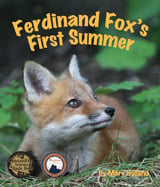Paper Birch Seeds Dispersing

Paper Birch (Betula papyrifera), also called White Birch, produces separate male and female flowers on the same tree, both in the form of catkins (cylindrical clusters of flowers). The catkins form in the fall and overwinter in a dormant state. In the spring they mature as the leaves develop, becoming pendulous. Male catkins are 2-4 inches long, whereas female catkins are usually 1–2 inches long. Both male and female flowers lack petals, enhancing wind pollination. After fertilization occurs, the male catkins wither away, while the female catkins droop downward and become cone-like.
The mature female catkins consist of tiny winged nutlets that are located behind three-lobed, hardened, modified leaves called bracts. Both winged seeds and bracts are usually dispersed by the wind during the fall and early winter. Birch bracts are species-specific — different species of birch have different-shaped bracts, allowing one to identify the species of birch that a bract comes from. Those of Paper Birch (pictured) look somewhat like soaring birds.
Naturally Curious is supported by donations. If you choose to contribute, you may go to http://www.naturallycuriouswithmaryholland.wordpress.com and click on the yellow “donate” button.
Black Bears Marking Territory & Mating
 Black Bear (Ursus americanus) breeding season begins in May and lasts until early July, with mating occurring mainly during June. The female traverses her territory at three times her normal rate during this time, laying down a scent trail which the male follows. Both male and female periodically intentionally deposit their scent by straddling vegetation, breaking off small limbs and biting, scratching and rubbing on trees (and telephone poles if available). Tree species often used for marking include White Birch, Balsam Fir, Striped Maple and Red Pine. When contact between the bears is eventually made, they nuzzle and chew on each other’s head and neck and may even wrestle a little. Mating occurs repeatedly for several days. (Thanks to Alfred Balch for photo op.)
Black Bear (Ursus americanus) breeding season begins in May and lasts until early July, with mating occurring mainly during June. The female traverses her territory at three times her normal rate during this time, laying down a scent trail which the male follows. Both male and female periodically intentionally deposit their scent by straddling vegetation, breaking off small limbs and biting, scratching and rubbing on trees (and telephone poles if available). Tree species often used for marking include White Birch, Balsam Fir, Striped Maple and Red Pine. When contact between the bears is eventually made, they nuzzle and chew on each other’s head and neck and may even wrestle a little. Mating occurs repeatedly for several days. (Thanks to Alfred Balch for photo op.)
Naturally Curious is supported by donations. If you choose to contribute, you may go to http://www.naturallycuriouswithmaryholland.wordpress.com and click on the yellow “donate” button.



















What Other Naturally Curious People Are Saying